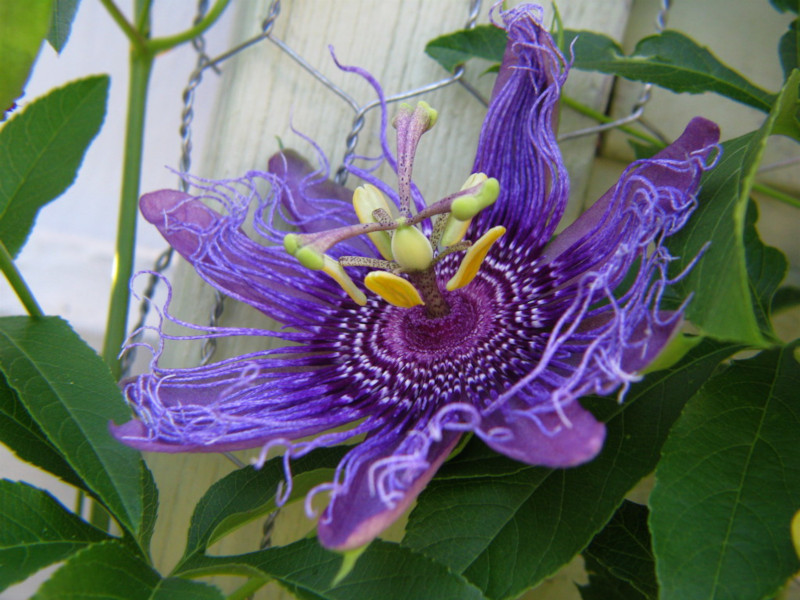
Purple Passionflower Facts
- The descriptive term of Purple Passionflower perfectly serves as one of the common names for this lovely and distinct beauty. It also has several other common names, though. These include such terms as the wild passion vine and the maypop.
- In addition to these, as well as several more, it also has a somewhat evocative scientific name, as well. That’s the equally appropriate term of the Passiflora incarnata. Regardless of the term chosen, though, it remains a most distinctive variety of flora.
- The first official recognition of this particular variety of passionflower, of which more than 600 exist, remains unclear, however. That’s due to conflicting reports.The first naming of the extremely extensive, as well as beautiful, genus, though, occurred in 1745.
- This occurred at the hands of the renowned Swedish botanist, Carl Linnaeus. The first recorded discovery of a member of this marvelous group happened in 1569. At that time, the Spanish doctor Monardes discovered one of them in South America.
- Very fortunately, the stunning Purple Passionflower also appears to be maintaining a sufficiently stable population throughout its range. The IUCN, therefore, presently does not have a listing for it. Any such listing would appear on the organization’s Red List.
- The wonder of Nature should, nonetheless, be considered to be at some risk, at least in its native range. It now exists around the world as an ornamental plant. Habitat loss poses a potential threat, but climate change likely remains its greatest.
Related Articles
Purple Passionflower Physical Description
It bears noting that the magnificent flora known as the Purple Passionflower evolved as a form of perennial vine. Given that fact, its exact dimensions understandably vary. For one, the marvel of Nature can develop as either a trailing or climbing variety.
In either variety, though, it remains capable of attaining a comparatively significant length. More precisely, some specimens also grow to a length of as much as 30 ft (9.1 m). The majority of individual plants, however, generally remain much shorter than this.
Its leaves typically develop a 3-lobed structure, but 5-lobed varieties do spontaneously occur in Nature. This foliage also usually presents a dark green in color, and possesses a smooth texture. On average, these reach a length equaling roughly 2.4 – 5.9 in (6 – 15 cm).
Yet, its the breathtaking and distinctive blooms of the aptly-named Purple Passionflower that garner the most attention. These develop 5 bluish-white petals, but further possess a bright purple and white corona. This naturally forms the source of the common name.
Though not as impressive as the gorgeous flowers, the fruit of the plant nonetheless merits its own attention. This also typically develops as an oval-shaped berry, roughly the size of a chicken egg. Although its starts out green in color, it slowly yellows as it matures.
- Kingdom: Plantae
- Phylum: Angiosperms
- Class: Eudicots
- Order: Malpighiales
- Family: Passifloraceae
- Genus: Passiflora
- Species: P. incarnata
Purple Passionflower Distribution, Habitat, and Ecology
Unlike some of its related species, the Purple Passionflower evolved as native a relatively wide section of the globe. In point of fact, it appears naturally in a specific portion of the continent of North America. It has, however, spread nearly worldwide.
More precisely, this wonder of evolution grows endemically in the southern and southeastern parts of the United States. This covers an area that extends from Pennsylvania in the northeast to Kansas in the mid-west, and as far south as Texas to Florida.
In the wild, this marvelous plant evolved as highly adaptable. As a result, it appears in a wide range of habitat types. These frequently include such areas as open fields, rocky slopes, thickets, thinly wooded regions, and sometimes even roadsides and ditches.
The plant does, however, greatly prefer these areas to be in mostly direct sunlight. Given the nature of its habitat, the beautiful Purple Passionflower accomplishes the majority of its pollination via the efforts of various local species of bumblebees and hummingbirds.
In some respects, unfortunately, the flora sometimes becomes considered an agricultural weed. It spreads prolifically. Historically, though, some people used it in traditional herbal medicines, and thus appreciated its extreme reproductive capabilities.
Species Sharing Its Range
Check out our other articles on 7 Bizarre Ocean Invertebrates, Black Rain Frog, Madeira, Long-Finned Pilot Whale, Lange’s Metalmark Butterfly, Flatback Sea Turtle, Puffin, Indigo Milk Cap
